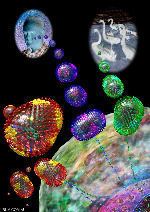In vitro and in vivo characterization of a novel H1N1/2009 influenza virus reassortant with an NS gene from a highly pathogenic H5N1 virus, isolated from a human
The triple-reassortant H1N1/2009 influenza A virus, which caused the first influenza pandemic of the 21st century, is generally associated with mild disease and a relatively low mortality rate comparable to that of seasonal influenza virus outbreaks. There is a growing concern about the potential for reassortment between the low-mortality H1N1/2009 and other high-mortality influenza viruses. Here, we describe and characterize a novel reassortant H1N1/2009 influenza virus, isolated from a human sample, that contained an NS gene from a highly pathogenic H5N1 virus. We evaluated the effect of the acquired NS gene on viral virulence both in vitro and in vivo and found that the novel NS-reassorted influenza virus replicated well in different cell lines and several organs of BALB/c mice without prior adaption and induced a cytokine imbalance. Therefore, there is a continued risk for further reassortment of the H1N1/2009 virus, and therefore, systematic surveillance should be enhanced to prepare for the next possible pandemic.
Influenzavirus mixing graphic from Russell Kightley Media
Ed Rybicki’s insight:
Not such a nice thing to read…!
In vitro and in vivo characterization of a novel H1N1/2009 influenza virus reassortant with an NS gene from a highly pathogenic H5N1 virus, isolated from a human
Source: Virology News
